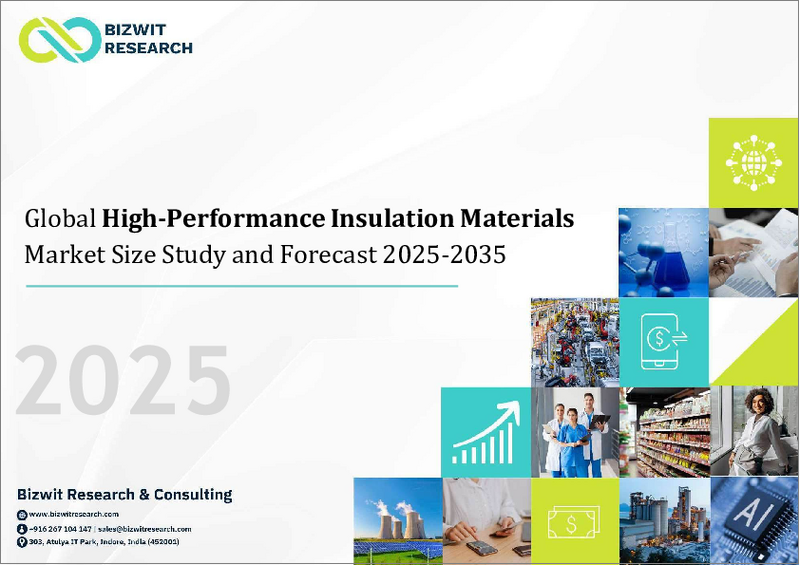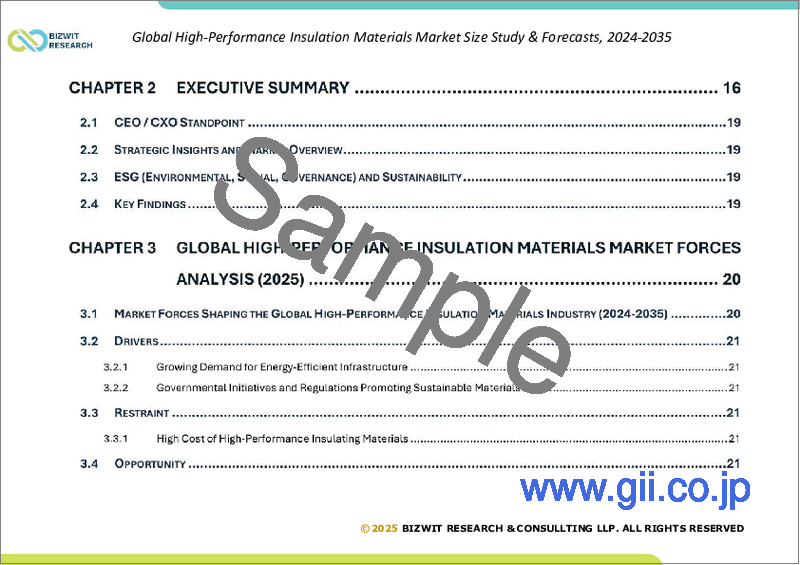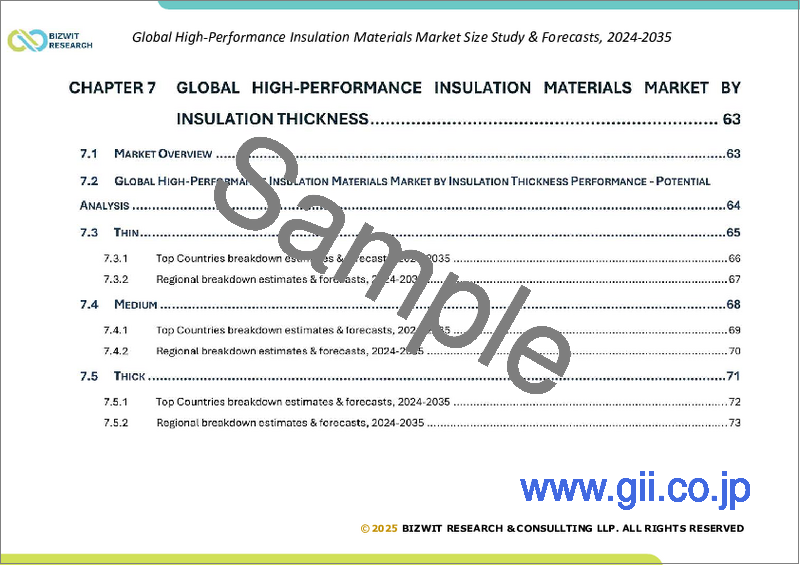|
|
市場調査レポート
商品コード
1783770
高性能断熱材の世界市場:市場規模の分析 (材料の種類別、用途別、断熱材の厚さ別、熱伝導率別、エンドユーザー産業別、地域別) と将来予測 (2025~2035年)Global High-Performance Insulation Materials Market Size Study & Forecast, by Material Type, Application, Insulation Thickness, Thermal Conductivity, End User Industry, and Regional Forecasts 2025-2035 |
||||||
カスタマイズ可能
|
|||||||
| 高性能断熱材の世界市場:市場規模の分析 (材料の種類別、用途別、断熱材の厚さ別、熱伝導率別、エンドユーザー産業別、地域別) と将来予測 (2025~2035年) |
|
出版日: 2025年08月04日
発行: Bizwit Research & Consulting LLP
ページ情報: 英文 285 Pages
納期: 2~3営業日
|
全表示
- 概要
- 目次
世界の高性能断熱材の市場規模は、2024年に約556億8,000万米ドルとなり、予測期間中(2025~2035年)にCAGR4.40%の安定した伸びが見込まれています。
高性能断熱材は、建設、輸送から航空宇宙、エレクトロニクスに至るまで、多くの産業においてエネルギー効率、耐熱性、安全性を確保する上で不可欠なものです。これらの材料は、優れた熱伝導性、低密度、難燃性、長持ちする耐久性を備えており、要求の厳しい環境において従来の断熱材に取って代わることができます。各国が省エネルギー、持続可能性、カーボンニュートラルを推進する中、断熱材はグリーン・インフラや製品設計戦略の中核的存在となっています。
この市場の背景にある勢いは、グリーンビルディングへの取り組みの急増と、エネルギー効率を促進する世界の環境機関が導入した厳しい規制政策によるところが大きいです。建設セクターが持続可能な慣行を採用するにつれ、ポリウレタンフォーム、ミネラルウール、セルラーガラス、ガラス繊維などの素材に対する需要が高まっています。さらに、HVACシステムや産業用途のOEMは、過酷な条件に耐えるだけでなく、作業効率も向上させる高断熱素材へとシフトしています。特に自動車や航空宇宙分野では、電気自動車や航空機キャビンの軽量化努力や熱管理をサポートするため、高度な断熱材が採用されています。材料科学の革新により、より薄く、より効果的な断熱材が可能になるにつれて、新たな用途が出現し続けています。
地域別に見ると、北米は建設産業と航空宇宙産業が発達しており、米国とカナダではエネルギー効率に関する指令が出されているため、現在高性能断熱材市場を独占しています。一方、欧州では、特にドイツやフランスなどの国々で、老朽化した住宅ストックの改築やEUの厳しいエネルギー効率指令が旺盛な需要を牽引しています。しかし、アジア太平洋は、中国、インド、東南アジアの急速な工業化、都市拡大、インフラ整備に後押しされ、予測期間中に最も急成長する見通しです。政府が支援するスマートシティプログラムは、商業および住宅部門における省エネ意識の高まりと相まって、この地域の普及を加速させています。さらに、電子機器製造拠点や交通インフラへの旺盛な投資が、APACベルト全域での断熱材需要を増幅しています。
当レポートの目的は、近年のさまざまなセグメントと国の市場規模を明らかにし、今後数年間の市場規模を予測することです。当レポートは、分析対象国における業界の質的・量的側面の両方を盛り込むよう設計されています。また、市場の将来的な成長を規定する促進要因や課題などの重要な側面に関する詳細な情報も提供しています。さらに、主要企業の競合情勢や製品提供の詳細な分析とともに、利害関係者が投資するためのミクロ市場における潜在的な機会も組み込んでいます。
市場の詳細なセグメントとサブセグメントは以下の通りです:
目次
第1章 世界の高性能断熱材市場:分析範囲・手法
- 分析目的
- 分析手法
- 予測モデル
- 机上分析
- トップダウンとボトムアップのアプローチ
- 分析の属性
- 分析範囲
- 市場の定義
- 市場区分
- 分析前提条件
- 包含と除外
- 制限事項
- 分析対象期間
第2章 エグゼクティブサマリー
- CEO/CXOの立場
- 戦略的洞察
- ESG分析
- 主な分析結果
第3章 世界の高性能断熱材市場:力学分析
- 世界の高性能断熱材市場を左右する市場力学(2024~2035年)
- 促進要因
- 建築・建設におけるエネルギー効率の高いインフラの需要の高まり
- 持続可能な素材を推進する政府の取り組みと規制
- 材料科学における技術進歩
- 抑制要因
- 高性能断熱材の高コスト
- 原材料価格の変動
- 機会
- 新興国におけるスマートシティとグリーンビルディングの拡大
- 航空宇宙産業とエレクトロニクス産業からの需要増加
第4章 世界の高性能断熱材産業の分析
- ポーターのファイブフォース分析
- 買い手の交渉力
- サプライヤーの交渉力
- 新規参入業者の脅威
- 代替品の脅威
- 競争企業間の敵対関係
- ポーターのファイブフォース:予測モデル(2024~2035年)
- PESTEL分析
- 政治的
- 経済的
- 社会的
- 技術的
- 環境的
- 法的
- 主な投資機会
- 主要成功戦略(2025年)
- 市場シェア分析(2024~2025年)
- 世界の価格分析と動向(2025年)
- アナリストの提言と結論
第5章 世界の高性能断熱材の市場規模・予測:材料の種類別(2025~2035年)
- ポリウレタンフォーム
- ポリスチレンフォーム
- ミネラルウール
- グラスファイバー
- セルラーガラス
第6章 世界の高性能断熱材の市場規模・予測:用途別(2025~2035年)
- 市場概要
- 工事
- 産業
- HVACシステム
- OEM
- 交通機関
第7章 世界の高性能断熱材の市場規模・予測:断熱材の厚さ別(2025~2035年)
- 市場概要
- 薄手
- 中間
- 厚手
第8章 世界の高性能断熱材の市場規模・予測:熱伝導率別(2025~2035年)
- 市場概要
- 低伝導率
- 中伝導率
- 高伝導率
第9章 世界の高性能断熱材の市場規模・予測:エンドユーザー産業別(2025~2035年)
- 市場概要
- 建築・建設
- 自動車
- 航空宇宙
- 海洋
- エレクトロニクス
第10章 世界の高性能断熱材の市場規模・予測:地域別(2025~2035年)
- 地域市場のスナップショット
- 主要先進国・新興国
- 北米
- 米国
- カナダ
- 欧州
- 英国
- ドイツ
- フランス
- スペイン
- イタリア
- その他欧州
- アジア太平洋
- 中国
- インド
- 日本
- オーストラリア
- 韓国
- その他アジア太平洋
- ラテンアメリカ
- ブラジル
- メキシコ
- 中東・アフリカ
- アラブ首長国連邦
- サウジアラビア
- 南アフリカ
- その他中東・アフリカ
第11章 競合情報
- 主要市場の戦略
- BASF SE
- 企業概要
- 主要幹部
- 企業のスナップショット
- 財務実績(データの入手可能性によります)
- 製品/サービスポートフォリオ
- 最近の開発
- 市場戦略
- SWOT分析
- Owens Corning
- Armacell International S.A.
- Saint-Gobain
- Johns Manville Corporation
- Kingspan Group
- Morgan Advanced Materials
- Recticel Group
- Covestro AG
- Huntsman Corporation
- Rockwool International A/S
- Knauf Insulation
- L'ISOLANTE K-FLEX S.p.A
- URSA Insulation S.A.
- Cabot Corporation
The Global High-Performance Insulation Materials Market is valued at approximately USD 55.68 billion in 2024 and is expected to register a steady compound annual growth rate (CAGR) of 4.40% over the forecast period from 2025 to 2035. High-performance insulation materials are indispensable in ensuring energy efficiency, thermal resistance, and safety across numerous industries-from construction and transportation to aerospace and electronics. These materials offer superior thermal conductivity, low density, fire resistance, and long-lasting durability, allowing them to replace traditional insulators in demanding environments. With nations pushing toward energy conservation, sustainability, and carbon neutrality, insulation materials have become a core enabler of green infrastructure and product design strategies.
The momentum behind this market is largely driven by an upsurge in green building initiatives and the strict regulatory policies introduced by global environmental agencies promoting energy efficiency. As the construction sector adopts sustainable practices, demand for materials such as polyurethane foam, mineral wool, cellular glass, and fiberglass has intensified. Furthermore, OEMs across HVAC systems and industrial applications are shifting toward high-insulating materials that not only withstand extreme conditions but also improve operational efficiency. The automotive and aerospace sectors, in particular, have embraced advanced insulation materials to support lightweighting efforts and thermal management in electric vehicles and aircraft cabins. As innovations in material science enable thinner yet more effective insulators, new applications continue to emerge.
From a regional perspective, North America currently dominates the high-performance insulation materials market due to its well-established construction and aerospace industries, as well as supportive energy-efficiency mandates across the U.S. and Canada. Meanwhile, Europe is witnessing robust demand driven by renovation of old housing stock and strict EU energy-efficiency directives, particularly in countries like Germany and France. However, the Asia Pacific region is poised to witness the fastest growth during the forecast period, fueled by rapid industrialization, urban expansion, and infrastructure development in China, India, and Southeast Asia. Government-backed smart city programs, coupled with increasing awareness of energy savings in the commercial and residential sectors, are accelerating regional adoption. Additionally, strong investments in electronics manufacturing hubs and transportation infrastructure amplify insulation demand across the APAC belt.
Major market players included in this report are:
- BASF SE
- Owens Corning
- Armacell International S.A.
- Saint-Gobain
- Johns Manville Corporation
- Kingspan Group
- Morgan Advanced Materials
- Recticel Group
- Covestro AG
- Huntsman Corporation
- Rockwool International A/S
- Knauf Insulation
- L'ISOLANTE K-FLEX S.p.A
- URSA Insulation S.A.
- Cabot Corporation
Global High-Performance Insulation Materials Market Report Scope:
- Historical Data - 2023, 2024
- Base Year for Estimation - 2024
- Forecast period - 2025-2035
- Report Coverage - Revenue forecast, Company Ranking, Competitive Landscape, Growth factors, and Trends
- Regional Scope - North America; Europe; Asia Pacific; Latin America; Middle East & Africa
- Customization Scope - Free report customization (equivalent up to 8 analysts' working hours) with purchase. Addition or alteration to country, regional & segment scope*
The objective of the study is to define market sizes of different segments & countries in recent years and to forecast the values for the coming years. The report is designed to incorporate both qualitative and quantitative aspects of the industry within the countries involved in the study. The report also provides detailed information about crucial aspects, such as driving factors and challenges, which will define the future growth of the market. Additionally, it incorporates potential opportunities in micro-markets for stakeholders to invest, along with a detailed analysis of the competitive landscape and product offerings of key players.
The detailed segments and sub-segments of the market are explained below:
By Material Type:
- Polyurethane Foam
- Polystyrene Foam
- Mineral Wool
- Fiberglass
- Cellular Glass
By Application:
- Construction
- Industrial
- HVAC Systems
- OEMs
- Transportation
By Insulation Thickness:
- Thin
- Medium
- Thick
By Thermal Conductivity:
- Low Conductivity
- Medium Conductivity
- High Conductivity
By End User Industry:
- Building & Construction
- Automotive
- Aerospace
- Marine
- Electronics
By Region:
- North America
- U.S.
- Canada
- Europe
- UK
- Germany
- France
- Spain
- Italy
- Rest of Europe
- Asia Pacific
- China
- India
- Japan
- Australia
- South Korea
- Rest of Asia Pacific
- Latin America
- Brazil
- Mexico
- Middle East & Africa
- UAE
- Saudi Arabia
- South Africa
- Rest of Middle East & Africa
Key Takeaways:
- Market Estimates & Forecast for 10 years from 2025 to 2035.
- Annualized revenues and regional level analysis for each market segment.
- Detailed analysis of geographical landscape with Country level analysis of major regions.
- Competitive landscape with information on major players in the market.
- Analysis of key business strategies and recommendations on future market approach.
- Analysis of competitive structure of the market.
- Demand side and supply side analysis of the market.
Table of Contents
Chapter 1. Global High-Performance Insulation Materials Market Report Scope & Methodology
- 1.1. Research Objective
- 1.2. Research Methodology
- 1.2.1. Forecast Model
- 1.2.2. Desk Research
- 1.2.3. Top Down and Bottom-Up Approach
- 1.3. Research Attributes
- 1.4. Scope of the Study
- 1.4.1. Market Definition
- 1.4.2. Market Segmentation
- 1.5. Research Assumption
- 1.5.1. Inclusion & Exclusion
- 1.5.2. Limitations
- 1.5.3. Years Considered for the Study
Chapter 2. Executive Summary
- 2.1. CEO/CXO Standpoint
- 2.2. Strategic Insights
- 2.3. ESG Analysis
- 2.4. Key Findings
Chapter 3. Global High-Performance Insulation Materials Market Forces Analysis
- 3.1. Market Forces Shaping the Global High-Performance Insulation Materials Market (2024-2035)
- 3.2. Drivers
- 3.2.1. Rising Demand for Energy-Efficient Infrastructure in Building & Construction
- 3.2.2. Governmental Initiatives and Regulations Promoting Sustainable Materials
- 3.2.3. Technological Advancements in Material Science
- 3.3. Restraints
- 3.3.1. High Cost of High-Performance Insulating Materials
- 3.3.2. Fluctuating Raw Material Prices
- 3.4. Opportunities
- 3.4.1. Expansion of Smart Cities and Green Buildings in Emerging Economies
- 3.4.2. Growing Demand from Aerospace and Electronics Industries
Chapter 4. Global High-Performance Insulation Materials Industry Analysis
- 4.1. Porter's 5 Forces Model
- 4.1.1. Bargaining Power of Buyer
- 4.1.2. Bargaining Power of Supplier
- 4.1.3. Threat of New Entrants
- 4.1.4. Threat of Substitutes
- 4.1.5. Competitive Rivalry
- 4.2. Porter's 5 Force Forecast Model (2024-2035)
- 4.3. PESTEL Analysis
- 4.3.1. Political
- 4.3.2. Economical
- 4.3.3. Social
- 4.3.4. Technological
- 4.3.5. Environmental
- 4.3.6. Legal
- 4.4. Top Investment Opportunities
- 4.5. Top Winning Strategies (2025)
- 4.6. Market Share Analysis (2024-2025)
- 4.7. Global Pricing Analysis and Trends 2025
- 4.8. Analyst Recommendation & Conclusion
Chapter 5. Global High-Performance Insulation Materials Market Size & Forecasts by Material Type 2025-2035
- 5.1. Market Overview
- 5.2. Polyurethane Foam
- 5.2.1. Top Countries Breakdown Estimates & Forecasts, 2024-2035
- 5.2.2. Market Size Analysis, by Region, 2025-2035
- 5.3. Polystyrene Foam
- 5.4. Mineral Wool
- 5.5. Fiberglass
- 5.6. Cellular Glass
Chapter 6. Global High-Performance Insulation Materials Market Size & Forecasts by Application 2025-2035
- 6.1. Market Overview
- 6.2. Construction
- 6.3. Industrial
- 6.4. HVAC Systems
- 6.5. OEMs
- 6.6. Transportation
Chapter 7. Global High-Performance Insulation Materials Market Size & Forecasts by Insulation Thickness 2025-2035
- 7.1. Market Overview
- 7.2. Thin
- 7.3. Medium
- 7.4. Thick
Chapter 8. Global High-Performance Insulation Materials Market Size & Forecasts by Thermal Conductivity 2025-2035
- 8.1. Market Overview
- 8.2. Low Conductivity
- 8.3. Medium Conductivity
- 8.4. High Conductivity
Chapter 9. Global High-Performance Insulation Materials Market Size & Forecasts by End User Industry 2025-2035
- 9.1. Market Overview
- 9.2. Building & Construction
- 9.3. Automotive
- 9.4. Aerospace
- 9.5. Marine
- 9.6. Electronics
Chapter 10. Global High-Performance Insulation Materials Market Size & Forecasts by Region 2025-2035
- 10.1. Regional Market Snapshot
- 10.2. Top Leading & Emerging Countries
- 10.3. North America
- 10.3.1. U.S.
- 10.3.1.1. Segment Breakdown Size & Forecasts, 2025-2035
- 10.3.2. Canada
- 10.3.2.1. Segment Breakdown Size & Forecasts, 2025-2035
- 10.3.1. U.S.
- 10.4. Europe
- 10.4.1. UK
- 10.4.2. Germany
- 10.4.3. France
- 10.4.4. Spain
- 10.4.5. Italy
- 10.4.6. Rest of Europe
- 10.5. Asia Pacific
- 10.5.1. China
- 10.5.2. India
- 10.5.3. Japan
- 10.5.4. Australia
- 10.5.5. South Korea
- 10.5.6. Rest of Asia Pacific
- 10.6. Latin America
- 10.6.1. Brazil
- 10.6.2. Mexico
- 10.7. Middle East & Africa
- 10.7.1. UAE
- 10.7.2. Saudi Arabia
- 10.7.3. South Africa
- 10.7.4. Rest of Middle East & Africa
Chapter 11. Competitive Intelligence
- 11.1. Top Market Strategies
- 11.2. BASF SE
- 11.2.1. Company Overview
- 11.2.2. Key Executives
- 11.2.3. Company Snapshot
- 11.2.4. Financial Performance (Subject to Data Availability)
- 11.2.5. Product/Services Port
- 11.2.6. Recent Development
- 11.2.7. Market Strategies
- 11.2.8. SWOT Analysis
- 11.3. Owens Corning
- 11.4. Armacell International S.A.
- 11.5. Saint-Gobain
- 11.6. Johns Manville Corporation
- 11.7. Kingspan Group
- 11.8. Morgan Advanced Materials
- 11.9. Recticel Group
- 11.10. Covestro AG
- 11.11. Huntsman Corporation
- 11.12. Rockwool International A/S
- 11.13. Knauf Insulation
- 11.14. L'ISOLANTE K-FLEX S.p.A
- 11.15. URSA Insulation S.A.
- 11.16. Cabot Corporation






